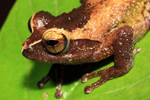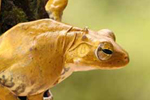Described by a number of media outlets as “the size of your face” a new tree-dwelling tarantula discovered in Sri Lanka has awed arachnophiliacs and terrified arachnophobes alike. But the new species, named Raja’s tiger spider (Poecilotheria rajaei), is likely Critically Endangered according to the scientist that discovered it in northern Sri Lanka.
“I would say that this species is Critically Endangered due to deforestation (the adults prefer well established old trees with naturally occurring tree hallows, where [their] spiderlings are found under bark peels, and small hollows),” Ranil Nanayakkara, co-founder of Sri Lanka’s Biodiversity Education and Research, told mongabay.com. He added that the species was also threatened by “wanton killing by villagers due […] fear of these animals and also certain pesticides and insecticides.”
In fact, the first time Nanayakkara ever saw the new species was in 2009 when a villager showed him a dead specimen that the local community had killed. Loss of habitat has forced a number of the spiders to invade the village of Mankulam, where they have been discovered hiding out in the hospital. Although venomous, the spiders are not thought to be lethal to humans.
Researchers believe the new species in only found in northern Sri Lanka, and—despite the 8-inch spread of its body—has likely gone unnoticed by scientists for so long due to war in the region. The species was described recently in the British Tarantula Society Journal.
The scientific team named the spider rajaei after local policeman, Michael Rajakumar Purajah, who proved indispensable to the team.
“[Purajah] helped me tremendously while in was in Mankulam with my field studies and was by my side 24/7/365,” Nanayakkara says.
Despite it’s formidable appearance, Nanayakkara says this spider in particular, and spiders in general, are often misunderstand.
“[Spiders] are natural bio-control agents, say for an example if there were no spiders, we would be bombarded by insect pests, as spiders on a whole feed on millions of insects in a day. The world over. Also their venom could well yield medicinal properties to cure modern aliments (studies are being carried out by me and my team),” he says, adding that, “Last but not least they have every right to this earth just like us humans, and they are wonders of nature.”
The island-country of Sri Lanka, which is just smaller than Ireland, has been in the news a lot recently for new and rediscovered species. Last month researchers announced the discovery of eight new species of frogs from one forest in Sri Lanka, while another frog was rediscovered after missing for over 150 years. The forests and biodiversity of Sri Lanka were hit hard by thirty years of civil war and today are increasingly imperiled by rapidly-expanding industrial agriculture. Only around 1.5 percent of Sri Lanka’s primary forest remains and scientists believe around 20 frogs have already vanished for good in the country.

New species of tarantula from Sri Lanka: Poecilotheria rajaei. Photo by: Ranil Nanayakkara.

Poecilotheria rajaei is a tree-climbing spider. Photo by: Ranil Nanayakkara.

Poecilotheria rajaei. Photo by: Ranil Nanayakkara.

Poecilotheria rajaei in close-up. Photo by: Ranil Nanayakkara.
CITATION: Nanayakkara, Ranil P. & Peter J. Kirk, Salindra K. Dayananda, G.A.S.M. Ganehiarachchi, Nilantha Vishvanath, T.G. Tharaka Kusuminda (2012): A new species of tiger spider, genus Poecilotheria, from northern Sri Lanka. BTS Journal. 28(1): 6-15.
Related articles
Scientists discover 8 new frogs in one sanctuary, nearly all Critically Endangered (photos)

(03/21/2013) Two surveys in the mountainous forests of Sri Lank’s Peak Wilderness Sanctuary have uncovered eight new species of frogs, according to a massive new paper in the Journal of Threatened Taxa. While every year over a hundred new amphibians are discovered, eight new discoveries in a single park is especially notable. Sri Lanka is an amphibian-lovers paradise with well over 100 described species, most of which are endemic, i.e. found only on the small island country. Unfortunately the country has also seen more frog extinctions than anywhere else, and seven of the eight new species are already thought to be Critically Endangered.
Starry frog rediscovered after thought extinct for 160 years (photos)

(03/07/2013) In 1853 Edward Frederick Kelaart, a physician and naturalist, collected a strange frog on the island of Sri Lanka then a British colony known as Ceylon. The specimen was a large shrub frog (about 2 inches or 5.5 centimeters long) with black-outlined white specks on lime-green skin. He dubbed it “starry” after its pale specks, but that was last anyone heard of it. Even the holotype—the body of the amphibian collected by Kelaart—went missing. Fast forward nearly 160 years—two world wars, Sri Lanka’s independence, and a man on the moon—when a recent expedition into Sri Lanka’s Peak Wilderness rediscovered a beguiling frog with pinkish specks.
Biofuel company caught clearing elephant habitat in Sri Lanka

(02/20/2013) A biofuel plantation near Yala National Park has landed Lanka Orex Leasing Company PLC (LOLC) in Sri Lanka’s highest court. Environmentalists say the company is illegally bulldozing Asian elephant habitat, including scrubland and tree stands, near the buffer zone of Yala National Park for gliricidia (Gliricidia sepium) biofuel plantation.
Sri Lanka to give poached ivory to Buddhist temple, flouting international agreements

(02/05/2013) The Sri Lankan government is planning to give 359 elephant tusks to a Buddhist temple, a move that critics say is flouting the Convention on International Trade in Endangered Species (CITES). The illegal tusks were seized in Sri Lanka last May en route to Dubai from Kenya; they are believed to stem from hundreds of butchered elephants, including juveniles, inside Africa, possibly Uganda. The decision comes after a high-profile National Geographic article, Ivory Worship, outlined how demand for ivory religious handicrafts, particularly by Catholics and Buddhists, is worsening the current poaching crisis. In 2011, it was estimated that 25,000 elephants were illegally slaughtered for their tusks.
New rare frog discovered in Sri Lanka, but left wholly unprotected

(11/05/2012) Sri Lanka, an island country lying off the southeast coast of India, has long been noted for its vast array of biodiversity. Islands in general are renowned for their weird and wonderful creatures, including high percentages of endemic species—and Sri Lanka, where scientists recently discovered a new frog species, is no exception.
Extinct toad rediscovered after hiding for 133 years in Sri Lanka

(06/18/2012) A small toad not seen since 1876, and considered by many to be extinct, has been rediscovered in a stream in Sri Lanka. First recorded in 1872, the Kandyan dwarf toad had (Adenomus kandianus) vanished for over a century before being found by scientists during a survey in 2009 in the Peak Wilderness Sanctuary, according to a new paper in Zootaxa.